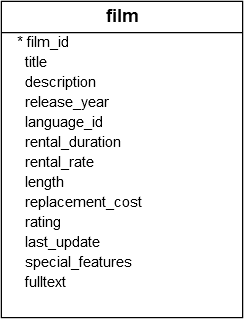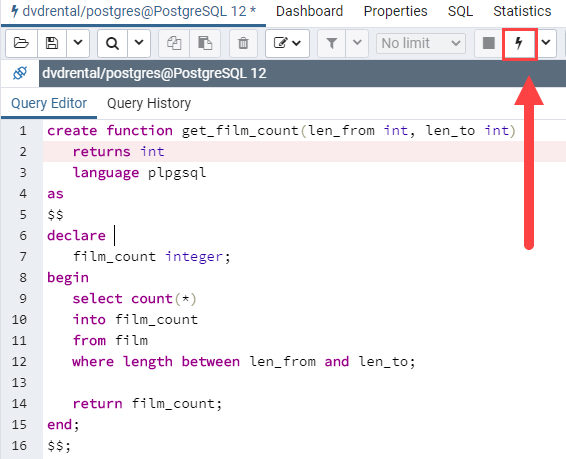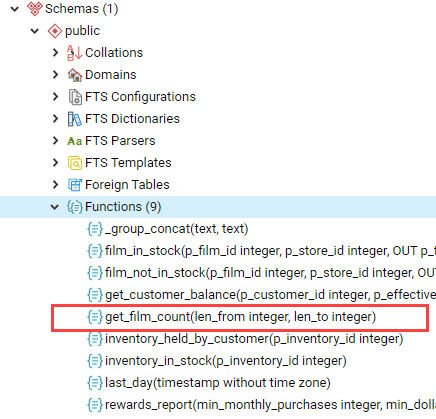August 4, 2023
Summary: in this tutorial, you will learn how to use the PostgreSQL CREATE FUNCTION statement to develop user-defined functions.
Table of Contents
Introduction to Create Function statement
The create function statement allows you to define a new user-defined function.
The following illustrates the syntax of the create function statement:
create [or replace] function function_name(param_list)
returns return_type
language plpgsql
as
$$
declare
-- variable declaration
begin
-- logic
end;
$$
In this syntax:
- First, specify the name of the function after the
create functionkeywords. If you want to replace the existing function, you can use theor replacekeywords. - Then, specify the function parameter list surrounded by parentheses after the function name. A function can have zero or many parameters.
- Next, specify the datatype of the returned value after the
returnskeyword. - After that, use the
language plpgsqlto specify the procedural language of the function. Note that PostgreSQL supports many procedural languages, not justplpgsql. - Finally, place a block in the dollar-quoted string constant.
PostgreSQL Create Function statement examples
We’ll use the film table from the dvdrental sample database.

The following statement creates a function that counts the films whose length between the len_from and len_to parameters:
create function get_film_count(len_from int, len_to int)
returns int
language plpgsql
as
$$
declare
film_count integer;
begin
select count(*)
into film_count
from film
where length between len_from and len_to;
return film_count;
end;
$$;
The function get_film_count has two main sections: header and body.
In the header section:
- First, the name of the function is
get_film_countthat follows thecreate functionkeywords. - Second, the
get_film_count()function accepts two parameters len_from and len_to with the integer datatype. - Third, the
get_film_countfunction returns an integer specified by thereturns intclause. - Finally, the language of the function is
plpgsqlindicated by thelanguage plpgsql.
In the function body:
- Use the dollar-quoted string constant syntax that starts with
$$and ends with$$. Between these$$, you can place a block that contains the declaration and logic of the function. - In the declaration section, declare a variable called
film_countthat stores the number of films selected from thefilmtable. - In the body of the block, use the
select intostatement to select the number of films whose length are betweenlen_fromandlen_toand assign the result to thefilm_countvariable. At the end of the block, use thereturnstatement to return thefilm_count.
To execute the create function statement, you can use any PostgreSQL client tool including psql and pgAdmin
1) Creating a function using pgAdmin
First, launch the pgAdmin tool and connect to the dvdrental sample database.
Second, open the query tool by selecting Tools > Query Tool.
Third, enter the above code int the query tool and click the Execute button to create the get_film_count function.

If everything is fine, you will see the following message:
CREATE FUNCTION
Query returned successfully in 44 msec.
It means that the function get_film_count is created successfully.
Finnally, you can find the function get_film_count in the Functions list:

In case you could not find the function name, you can right-click the Functions node and select Refresh… menu item to refresh the function list.
2) Creating a function using psql
First, launch the psql interactive tool and connect to the dvdrental database.
Second, enter the above code in the psql to create the function like this:
dvdrental=# create function get_film_count(len_from int, len_to int)
dvdrental-# returns int
dvdrental-# language plpgsql
dvdrental-# as
dvdrental-# $$
dvdrental$# declare
dvdrental$# film_count integer;
dvdrental$# begin
dvdrental$# select count(*)
dvdrental$# into film_count
dvdrental$# from film
dvdrental$# where length between len_from and len_to;
dvdrental$#
dvdrental$# return film_count;
dvdrental$# end;
dvdrental$# $$;
You will see the following message if the function is created successfully:
CREATE FUNCTION
Third, use the \df command to list all user-defined in the current database:
dvdrental=# \df
Calling a user-defined function
PostgreSQL provides you with three ways to call a user-defined function:
- Using positional notation
- Using named notation
- Using the mixed notation.
1) Using positional notation
To call a function using the positional notation, you need to specify the arguments in the same order as parameters. For example:
select get_film_count(40,90);
Output:
get_film_count
----------------
325
(1 row)
In this example, the arguments of the get_film_count() are 40 and 90 that corresponding to the from_len and to_len parameters.
You call a function using the positional notation when the function has few parameters.
If the function has many parameters, you should call it using the named notation since it will make the function call more obvious.
2) Using named notation
The following shows how to call the get_film_count function using the positional notation:
select get_film_count(
len_from => 40,
len_to => 90
);
Output:
get_film_count
----------------
325
(1 row)
In the named notation, you use the => to separate the argument’s name and its value.
For backward compatibility, PostgreSQL supports the older syntax based on := as follows:
select get_film_count(
len_from := 40,
len_to := 90
);
3) Using mixed notation
The mixed notation is the combination of positional and named notations. For example:
select get_film_count(40, len_to => 90);
Note that you cannot use the named arguments before positional arguments like this:
select get_film_count(len_from => 40, 90);
Error:
ERROR: positional argument cannot follow named argument
LINE 1: select get_film_count(len_from => 40, 90);
In this tutorial, you have learned how to use the CREATE FUNCTION statement to create a user-defined function.

